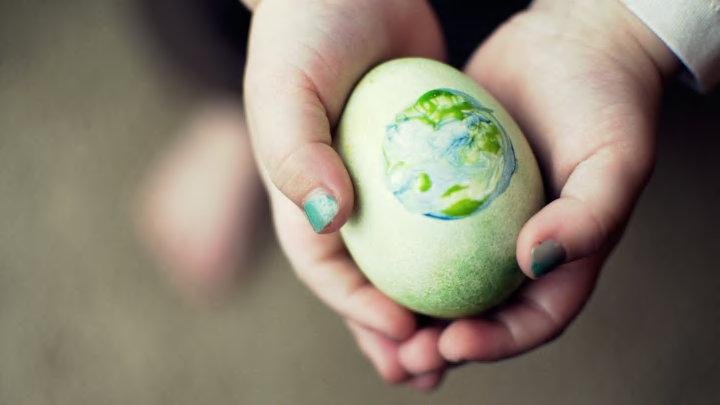Easter is celebrated around the globe, but the customs can be very different depending on where you live. The feast dishes, the public celebrations, and even the candy we consume often have a local flavor.
- Sweden // Easter Witches
- Australia // The Easter Bilby
- Ecuador // Fanesca, the Easter Soup
- Newfoundland and Labrador // Seal Flipper Pie
- Hungary // Vízbetevő
- Italy // Giant Chocolate Eggs
Sweden // Easter Witches

Sweden has an Easter tradition with roots in pre-Christian Europe: On Maundy Thursday (Skärtorsdag), children go trick-or-treating. The Thursday before Easter was once said to be the day all witches flew on their broomsticks to a mountain to cavort with the devil. They flew back to their homes on Saturday, and tried to blend in with the rest of the churchgoers on Easter Sunday. In memory of this belief, children in Sweden and parts of Finland dress as witches (and sometimes other pop culture characters) and go from house to house seeking candy. Another related tradition is for people to build bonfires to ward off the returning witches flying overhead.
Australia // The Easter Bilby

Australians aren’t big fans of rabbits. The furry creatures are an invasive species that has destroyed much of the native flora and supplanted the native fauna. So, Australians have never been too keen on the idea of the Easter bunny bringing treats. But a bilby—a native marsupial with long ears—was a different story: In 1968, 9-year-old Rose-Marie Dusting of Queensland wrote a story called “Billy The Aussie Easter Bilby,” which she later published. In 1991, an official campaign was launched to promote the Easter bilby, and chocolatiers followed by fashioning candy bilbies for Easter baskets. The gift of a chocolate bilby is not only a holiday tradition now, but also a statement of Aussie pride.
Ecuador // Fanesca, the Easter Soup
Fanesca is a traditional Easter soup in Ecuador. It’s said to be made only once a year because the preparation is so time-consuming, and because each recipe makes such a large batch. The ingredients include a variety of fresh grains and beans, squash, salted cod, cheese, and milk. The 12 grains and beans are said to represent the 12 apostles, and the cod represents Jesus.
Newfoundland and Labrador // Seal Flipper Pie
The Inuit of eastern Canada have long hunted seals in the spring. When Europeans arrived, they found that all parts of the seal could be sold—except for the flippers, which were relatively tough. Those were kept for home consumption, and cooks improved them by coating them in flour, frying with onions and other vegetables, and then baking into a pie. Since it was made during the spring hunting season, seal flipper pie became traditional for Lent and Easter in the provinces of Newfoundland and Labrador. Today, it’s served in restaurants and sold in groceries for the Easter season.
Hungary // Vízbetevő
An Easter tradition in Hungary involves throwing buckets of water on young women of marriageable age. On the day after Easter, the women dress up in traditional clothing, and young men douse them with water in a custom called “Water Sowing Monday,” or Vízbevető. This is supposed to be a pre-Christian cleansing ritual to promote fertility, which has evolved into a tradition that is sometimes an excuse for flirting with the opposite sex, and sometimes just a nuisance.
The custom isn’t limited to Hungary. In Poland, it’s known as Śmigus-Dyngus (you can see it in the video above). There are variations in other Eastern European countries as well. In some places, you don’t need to dress up to get wet; in others, a little spritz of perfume replaces the drenching. Sometimes the dowsing is accompanied by poetry reading or symbolic “whipping” with pussy willows. Traditionally, the girls are supposed to return the favor on Tuesday, but in reality, all the shenanigans happen on the same day.
Italy // Giant Chocolate Eggs
In Italy, the tradition of celebrating Easter with eggs and candy has evolved into the custom of giving gifts tucked inside chocolate eggs. There are mass-produced chocolate eggs with treats inside for children, somewhat akin to Kinder Surprise eggs, except the Italian version for the holiday is much larger. There are also beautiful artisanal eggs made by chocolatiers, either wrapped in fancy paper and ribbons or decorated with intricate edible art right on the chocolate. The gifts inside are often customized—it’s not unusual to present an engagement ring or a set of car keys in this manner. More typical would be gold jewelry for one’s spouse, or a toy that one’s child has been craving. An internet search for “Italian chocolate Easter eggs” yields several chocolatiers who will ship the eggs to you.
Read More Stories About Customs From Around the World:
A version of this story ran in 2016; it has been updated for 2024.
